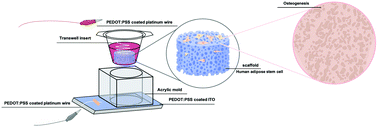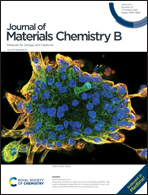Rational design of a highly porous electronic scaffold with concurrent enhancement in cell behaviors and differentiation under electrical stimulation†
Abstract
Conductive polymers (CPs) have received increasing attention as promising materials for studying electrophysiological signals in cell and tissue engineering. The combination of CPs with electrical stimulation (ES) could possibly enhance neurogenesis, osteogenesis, and myogenesis. To date, research has been prioritized on capitalizing CPs as two-dimensional (2D) structures for guiding the differentiation. In contrast, relatively little is conducted on the implementation of 3D conductive scaffolds. In this research, we report the synergic assembly of poly(3,4-ethylenedioxythiophene):poly(styrenesulfonate) (PEDOT:PSS) and multi-walled carbon nanotubes (MWCNTs) as a biocompatible, electrically conductive, mechanically robust and structurally porous 3D scaffold. To showcase the bioelectronic utilization, a proof-of-concept demonstration of electrically stimulated cell culture under ES is conducted. The ES effects coupled with the 3D scaffold are promising on pheochromocytoma 12 (PC12), a neuronal cell line, and the ES effect on osteogenesis of human adipose-derived stem cells (hASC) was further studied. PC12 cultured on this PEDOT:PSS/MWCNT 3D scaffolds was induced to differentiate toward a more mature neuronal phenotype with the ES treatment. Furthermore, hASC osteogenesis could be highly promoted in this conductive scaffold with ES. Calcium deposition concentration and osteo-differentiated gene markers were significantly higher with ES. The facile assembly of 3D conductive scaffolds sheds light on both platforms for investigating the 3D microenvironment for electrophysiological simulation of cells and tissues under the ES treatment of in vivo tissue engineering.



 Please wait while we load your content...
Please wait while we load your content...